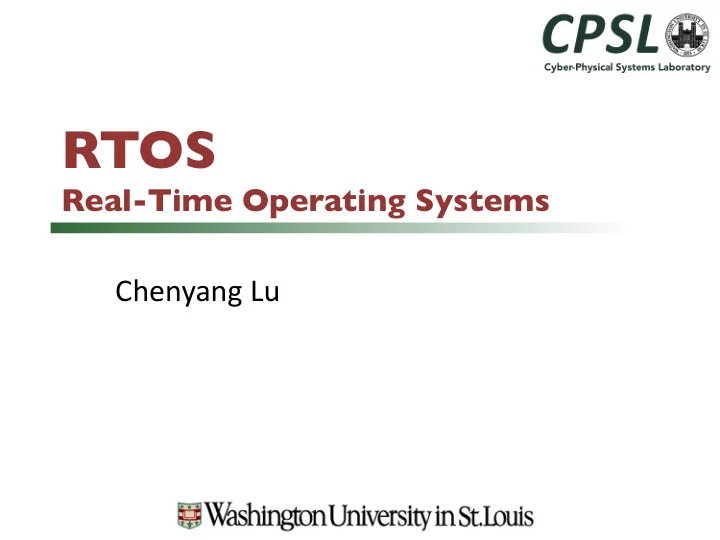

RTOS Real-Time Operating Systems Chenyang Lu
OS Support for Real-Time Ø Real-Time OS Ø Real-time extensions to general-purpose OS Chenyang Lu 2
RTOS: Features for Efficiency Ø Small Ø Minimal set of functionality Ø Fast context switch Ø Fast and time bounded response to interrupts Ø Fixed or variable partitions of memory q May not support paging or virtual memory q May support locking code and data in memory Ø Sequential file that can accumulate data at fast rate q May be memory-based Chenyang Lu 3
Code Size Name Code Size Target CPU pOSEK 2K Microcontrollers pSOSystem PII->ARM Thumb VxWorks 286K Pentium -> Strong ARM QNX Nutrino >100K Pentium II -> NEC QNX RealTime 100K Pentium II -> SH4 OS-9 Pentium -> SH4 Chorus OS 10K Pentium -> Strong ARM ARIEL 19K SH2, ARM Thumb Creem 560 bytes ATMEL 8051 Chenyang Lu 4
RTOS: Features for Real-Time Ø Preemptive priority scheduling q At least 32 priority levels, commonly 128-256 priority levels q Priority inheritance/ceiling protocol Ø System calls q Bounded execution times q Short non-preemptable code Ø High-resolution system clock q Resolution down to nanoseconds q But it takes about a microsecond to process a timer interrupt Chenyang Lu 5
Other Important Features Ø Conformance to standards q Real-Time POSIX API q TCP/IP Ø Modularity and configurability q Small kernel q Pluggable modules Chenyang Lu 6
Example: VRTX Ø VRTXsa q RT -POSIX compliant q Full real-time support Ø VRTXmc q Optimized for power and footprint Ø First RTOS certified by FAA q 100% code coverage in testing Ø Runs the Hubble Space Telescope Chenyang Lu 7
Real-Time Extensions to General OS Ø Generally slower and less predictable than RTOS Ø More functionality and development support Ø Standard interfaces Ø Suitable for soft real-time applications Chenyang Lu 8
How Real-Time Is Linux? Ø I believe that Linux is ready to handle applications requiring sub- millisecond process-scheduling and interrupt latencies with 99.99+ percent probabilities of success . No, that does not cover every imaginable real-time application, but it does cover a very large and important subset. Ø The Linux 2.6 kernel, if configured carefully and run on fast hardware, can provide sub-millisecond interrupt and process scheduling latencies with extremely high probabilities of success. Ø There are patches out there that are expected to provide latencies in the tens of microseconds . These patches need some work, but are maturing quickly. Paul McKenney, IBM Linux Technology Center Shrinking slices: Looking at real time for Linux, PowerPC, and Cell Chenyang Lu 9
Why isn’t Linux real-time? Ø The Linux kernel only allows a process to preempt another under certain circumstances: q when the CPU is running user-mode code; q when kernel code returns from a system call or an interrupt to user space; q when kernel code blocks on a mutex, or explicitly yields control to another process. Ø If kernel code is executing, a high priority thread cannot preempt the kernel until the kernel code yields control. Ø In the worst case , the latency could potentially be hundreds milliseconds or more. Source: https://rt.wiki.kernel.org/ Chenyang Lu 10
Linux Scheduling Ø Real-time scheduling class q Fixed priority • SCHED_FIFO: First-In-First-Out • SCHED_RR: Round-Robin q Earliest Deadline First • SCHED_DEADLINE Ø Non-real-time scheduling class (SCHED_NORMAL) Ø Default q Real-time: 0 – 99 q Non-real-time: 100 – 139 Chenyang Lu 11
Real-time Linux Ø Core kernel modifications: patches q Require modifications to Linux kernel q Example: CONFIG_PREEMPT_RT patch Ø Compliant kernels: modified native RTOS q Linux binaries can run without modifications q Example: LynxOS Ø Dual kernels: real-time kernel sits below Linux q Real-time kernel traps all interrupts and schedules all processes q Linux runs as a low-priority process q Example: RT -Linux (FSLabs) Chenyang Lu 12
CONFIG_PREEMPT_RT Patch Ø Convert Linux into a fully preemptible kernel. Ø Locks q Making in-kernel locking-primitives preemptible through reimplementation with rt-mutexes. q Critical sections protected by spinlock_t and rwlock_t are preemptible. q Priority inheritance for in-kernel spinlocks and semaphores. Ø Convert interrupt handlers into preemptible kernel threads. Ø Convert timer API into separate infrastructures for high resolution kernel timers plus one for timeouts, leading to user space POSIX timers with high resolution. Source: https://rt.wiki.kernel.org/ Chenyang Lu 13
Multi-core Real-Time Scheduler Ø Push-pull scheduler schedules tasks across CPUs. Ø Every CPU has a runqueue. Ø Push: considers all the runqueues within its root domain to find the one of a lower priority than the task being pushed. q Push a task when it wakes up on a runqueue running a task of higher priority q Push a task when a higher-priority task on the same runqueue wakes up and preempts it Ø Pull: whenever a runqueue is about to schedule a task that is lower in priority than the previous one, it checks whether it can pull tasks of a higher priority from other runqueues. Chenyang Lu 14
RT-Linux • Real-time kernel traps all interrupts and schedules all processes • Linux runs as a low-priority process • Real-time applications cannot take advantage of Linux calls Linux Process Linux Process RT Process Linux Kernel Software Interrupts Scheduling Real-Time Kernel Hardware Interrupts Chenyang Lu 15
More Information Ø Real-Time Linux Wiki: https://rt.wiki.kernel.org/index.php/Frequently_Asked_Questions Ø Real-Time Linux Kernel Scheduler: http://www.linuxjournal.com/magazine/real-time-linux-kernel-scheduler Chenyang Lu 16
Recommend
More recommend